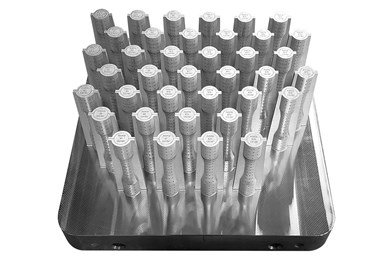AddUp Participates in $1.5M USAF Research on IN-718 Additive Manufacturing
AddUp is partnering with Zeda to provide critical project support to provide the USAF with a set of manufacturing guidelines to maximize the capabilities of LPBF to meet fleet readiness and sustainment goals.
AddUp Inc. has joined a $1.5 million research contract for the “Development of Manufacturing, Heat Treatment and Surface Finishing Guidelines to Yield Ready-to-Use IN-718 Additive Manufacturing Components” for the United States Air Force (USAF). The program is being run through the USAF and the Small Business Innovation Research (SBIR) program led by REM Surface Engineering (REM).
The USAF is constantly seeking innovative solutions to enhance the readiness and performance of its armament systems. In pursuit of this goal, this project was proposed and awarded. It is funded through a Direct to Phase II Small Business Innovation Research (SBIR) contract, and aims to harness the potential of laser powder bed fusion (LPBF) and surface finishing technologies to produce IN-718 components for legacy armament systems.
This endeavor is researching the impact of various heat treatment and printing parameter combinations in association with REM’s surface finishing technology on a component’s mechanical properties, such as tensile strength and fatigue life. AddUp and Zeda (formerly PrinterPrezz and Vertex Manufacturing) are providing critical support to this project which aims to provide the USAF with a set of manufacturing guidelines to maximize the capabilities of LPBF to meet fleet readiness and sustainment goals.
Fatigue strength plays a critical role in ensuring the reliability and longevity of components used in demanding applications within the USAF. IN-718, a nickel-based superalloy material known for its exceptional mechanical properties and resistance to high temperatures and corrosive environments, has gained significant importance in aerospace and defense industries.
The combination of fine powder and a roller recoater in AddUp’s FormUp 350 machine provides a synergistic effect on surface finish improvement, leading to enhanced fatigue properties in IN-718 material. By achieving a more uniform powder layer, reducing surface irregularities and minimizing defects, the fatigue resistance of the printed components is significantly improved. This is particularly crucial in aerospace and defense applications, where fatigue performance is critical for long-term structural integrity and operational reliability.
To ensure the integrity and reliability of the IN-718 AM components, fatigue testing is a crucial step. AddUp, in collaboration with Zeda, will manufacture IN-718 fatigue specimens using LPBF technology with AddUp’s FormUp 350. These specimens will be utilized in REM’s testing matrix to establish expected material properties of LPBF components with several levels of surface finish and with different manufacturing and heat treatment parameters. Through this collaborative effort, the project seeks to validate the fatigue strength of IN-718 AM components manufactured via AddUp’s FormUp 350 LPBF technology.
The development of manufacturing, heat treatment, and surface finishing guidelines to yield ready-to-use IN-718 Additive Manufacturing Components project represents a significant step forward in advancing the USAF's capabilities and readiness. By leveraging the capabilities of LPBF technology and conducting rigorous fatigue testing, this project strives to enhance the performance, reliability and cost-effectiveness of aerospace and defense components production, reducing downtime and ensuring mission-critical operations can proceed smoothly.
- Read more about Zeda collaborating with AddUp for aerospace, medical additive manufacturing. The first of eight AddUp FormUp 350 powder bed fusion machines deployed has been installed at Zeda to support its growth in the aerospace and medical sectors.
- Read about the new Zeda additive manufacturing factory in Ohio that will serve medical, military and aerospace production, and includes laser powder bed fusion (LPBF) machines from AddUp and Velo3D.
Related Content
Do Distributors Dream of Digital Inventory? Würth Additive Group Does
It’s more than a dream for Würth Additive Group and its parent company, in fact. Along with supplying additive equipment, the group is now developing solutions for sourcing 3D printed parts in a reliable, elastic digital inventory model.
Read MoreSeurat: Speed Is How AM Competes Against Machining, Casting, Forging
“We don’t ask for DFAM first,” says CEO. A new Boston-area additive manufacturing factory will deliver high-volume metal part production at unit costs beating conventional processes.
Read MoreThe Cold Spray Solution to the Casting, Forging Supply Chains
Startup HAMR Industries performs additive manufacturing work at Neighborhood 91 that provides an alternative to traditional casting and forging. Success so far has led to redefining the limits of its additive equipment.
Read MoreAdditive Manufacturing and the War in Ukraine: AM Radio #19
In this latest episode of the AM Radio podcast, we dive into the ways that AM is providing aid and also being affected by the conflict in Ukraine.
Read MoreRead Next
At General Atomics, Do Unmanned Aerial Systems Reveal the Future of Aircraft Manufacturing?
The maker of the Predator and SkyGuardian remote aircraft can implement additive manufacturing more rapidly and widely than the makers of other types of planes. The role of 3D printing in current and future UAS components hints at how far AM can go to save cost and time in aircraft production and design.
Read More4 Ways the Education and Training Challenge Is Different for Additive Manufacturing
The advance of additive manufacturing means we need more professionals educated in AM technology.
Read More3D Printing Brings Sustainability, Accessibility to Glass Manufacturing
Australian startup Maple Glass Printing has developed a process for extruding glass into artwork, lab implements and architectural elements. Along the way, the company has also found more efficient ways of recycling this material.
Read More










.png;maxWidth=300;quality=90)













